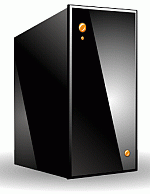Clients ask how much a new server costs. It depends (of course).
We recommend that our clients buy servers from Dell. We’ve been working with Dell equipment for a long time now and while the quality of the service does ebb and flow, our sense is that we do as well with Dell as we would with any hardware vendor and that most of the time we do better than we would with other vendors. The quality of their server builds is very solid and they are able to back that quality with a huge, knowledgeable and professional technical support team.
A simple file physical file server and domain controller probably just needs a couple of drives configured in a simple RAID1 mirror. SATA drives are the lowest cost per gigabyte, but we’ve been seeing Serial Attached SCSI drives closing the dollar/gigabyte gap and since they have better performance and longer lives, we prefer SAS.
One processor is probably fine and 8-16 GB of RAM will likely do the trick. In the end, such a setup can be had for not a terrible amount of money, though for our clients who are looking to go on the very low end of server hardware investments, we sometimes ask if going without a server altogether is a viable alternative. Until recently, going without a server – using hosted solutions for file sharing and email and giving up the benefits of a Microsoft domain – is something we’d not have recommended to any but our very smallest clients, but nowadays it’s something we consider for up to 15 seats in a given office. In these days of bring your own device, the advantages of a domain are diminishing.
At the other extreme are clients who need their servers to run a virtualization platform supporting multiple virtual server guests. Such servers need more than just a couple hard disks with a more complex redundancy configuration. Dual, faster processors and much more RAM is required. The price can go up quickly.
More considerations:
• For projects in which we’ll be installing VMware’s ESXi virtualization platform, we recommend the mirrored internal 1GB SDCards available on Dell’s 12th generation servers.
• We recommend Dell’s Enterprise DRAC cards on the 12th generation servers. They allow us to connect to the server’s console over an Ethernet connection, giving us not only remote access to the Windows operating system (which we’ve had for years), but to the server’s BIOS and LifeCycle Platform, allowing remote firmware updates and the like.
• We sometimes add additional network interface cards if different virtual guests will be on different network subnets within the client’s overall network.
• Power supplies are an occasional point of failure on servers, though easily remedied with a new one (quickly installed – just slide out the old one and slide in the new one). But if you can’t afford downtime while you wait for Dell to deliver a replacement part, you should get redundant power supplies. It’s not a lot more money and one of the redundant features on servers we recommend, depending on uptime requirements.
Finally, we always discuss with the client how much they want to invest in Dell’s warranty/support programs. All Dell servers come with a three year Basic warranty which provides phone access to Dell’s support technicians 10 hours each business day and promises covered replacement parts by the end of the next business day. It’s actually a pretty solid warranty and we don’t experience Dell trying to duck the responsibilities it promises.
However, for clients who can’t afford extended server downtime an upgrade to one of Dell’s 24×7 four hour delivery warranties is a good business decision. We’ve had parts delivered for a mission critical server at 11PM on a Saturday night. Our starting recommendation to clients in most cases is to make this investment.

